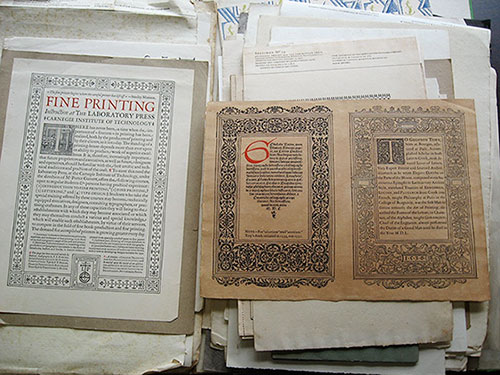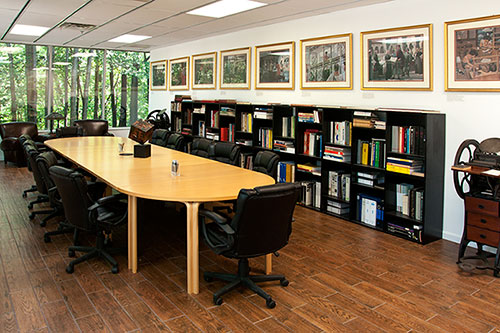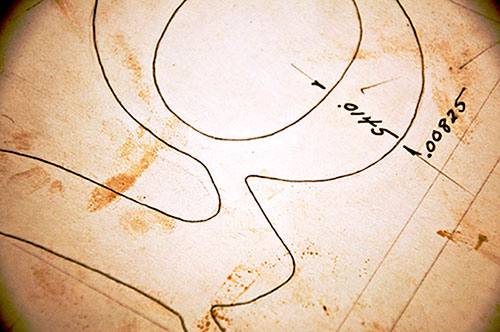Hand Draw the Inland Printer a Technical Journal to the Art of Printing
Libraries
The Romano Library

Over 6,000 books and thousands of ephemera samples are housed in a unique library which is now part of the Museum of Printing. Frank Romano has spent 60 years collecting books almost printing.
At that place is a rare copy of Savage'southward 1822 treatise on Decorative Arts and an origional Dard Hunter. Complete sets of the Inland Printer and New England Printer are joined by the Penrose Annual and other publications.
Most of the collection is in 32 floor-to-ceiling custom-made mahogany bookcases with display cases that document Fred Goudy and the Nuremberg Chronicle and other aspects of print history.
An AV room stores archival slides and electronic media with vintage projectors and converters.
This Library houses the largest collection of material from the Mergenthaler Linotype Company and also maintains an archive of material from the phototypesetting and desktop publishing eras. For more info on this, please read further >
The Romano Library is augmented by:
The Frey Collection
Introductory Notes by Nancy Trottier, MOP Archivist

Edward J. Frey was a scholar-printer from New York. Built-in into a family of printers, he was also more than formally educated in the New York Public School system, learning letterpress printing through their vocational technical curriculum. In the early 1920's he himself applied for instructor positions with vocational technical programs in the same school organization. He succeeded in obtaining his first teaching position with Public School #45, The Bronx, New York City, known every bit the Angelo Patri Schoolhouse.
During his 35 year long teaching career in the New York Public School system, Mr. Frey began to develop curriculum that was at once comprehensive and compartmentalized for delivery to the student. He continued this curriculum evolution and delivery work through his involvement with the Full general Studies Program at Columbia University for the next eighteen years and the Adult Education Program for the Poppenhusen Found, College Point, New York. At Columbia Mr. Frey created a Graphic Arts Technology Program for the Occupational Therapy Sectionalisation of the General Studies Plan. This curriculum, and those created by other printer-scholars of the 20th century, was a major building block for what many educators recognize as The Print Ed Plan used widely in secondary schools and community colleges for over 60 years.
At the aforementioned time he was very involved in instruction, Mr. Frey also operated The Garden Press in Chappaqua, New York, from 1922 until 1978, when he entered his 95th year and decided to dispose of his library and ephemera collection and his store equipment. During his lifetime he accumulated a huge archive of magazine articles, press and paper sample books, pamphlet books, zines, and numerous type sample catalogues. Mr. Frey, similar many of the scholar-printers of the early on to mid twentieth century, had a love of fine typography and kept numerous scrapbooks illustrating typographic layouts, sample proof pages, design schemes for business organisation cards, brochures, show cards, and stationery. His family has donated Frey's huge ephemera drove, his correspondence archive, and a proficient deal of his shop equipment and type, to The Press Museum. Nosotros are the copyright holders for this collection.
We are currently actively involved in sorting through the estimated 100,000 individual pieces of the Frey collection to identify all the contents of the correspondence annal, printing samples, educational didactic cloth, and photographs. Information technology is our hope over the side by side two years to make this vast annal of irreplaceable cloth available to scholars and connoisseurs of the history of printing. This page is just one visual sampling of some of the material we are discovering.
The Fowler Collection
 The Museum of Press is about so much more than beautiful old press presses, cool tools, and interesting history. Yes, we love our equipment but nosotros're almost art too. Check out our fantastic art exhibit of Mark Fowler's piece of work, now on permanent exhibit.
The Museum of Press is about so much more than beautiful old press presses, cool tools, and interesting history. Yes, we love our equipment but nosotros're almost art too. Check out our fantastic art exhibit of Mark Fowler's piece of work, now on permanent exhibit.
Marker Fowler was an exceptional artist and printer. Influenced by Japanese colour woodblock printing techniques, he used relief printing to share his peachy love of the natural earth. He produced richly colored still lifes of birds, copse, flowers and landscapes, i a yr, entirely by hand.
This exhibit chronologically presents 43 of his works along with displays of his sketches, engravings and blocks, tools, color palettes, progressive proofs, research materials and notes. These works on paper by a lesser-known creative person will inspire printers and artists alike!
The exhibit is on view every Saturday from ten a.m. to 4 p.m. Reasonably priced archival-quality digital reproduction prints, note cards, and letterpress impressions from Fowler's wood engravings are available for sale in our store.
The John Trieste Memorial Type Library

The John Trieste Memorial Library is a typographic reference library surrounded past large windows on two sides. Type specimen books, typographic publications, and other materials allow inquiry on typefaces past and present.
It is also available every bit a meeting room holding well-nigh a dozen people in costly chairs effectually a long conference table.
The Mergenthaler Font Library

Falling under the auspices of the Richter Library is one of the globe's nearly unique collections, The Mergenthaler Font Library. When this large collection, most 300,000 drawings, arrived in North Andover, it arrived in ane and a half trailer truck loads, 37 skids, 7 feet high. This collection came to the museum from Heidelberg International through the skilful efforts of the Smithsonian Institution. This collection contains all of the intricate letter of the alphabet drawings fabricated by the Mergenthaler Linotype Visitor in Brooklyn, New York. These drawings were the starting signal of manufacturing matrices for Linotype machines, enabling users to set blazon on these machines in 800 dissimilar languages and dialects.
The Intertype Photosetter Font Library
Much smaller than the Mergenthaler Library and nevertheless a sizable body of work, this library correspond a different medium. The Intertype Photosetter was designed during the 1940s by Intertype Corpoartion in New York in response to the steadfast march of press, starting in nearly 1910, from letterpress, relief printing to commencement lithography. When it became obvious to Intertype that kickoff lithography would eventually displace most letterpress press and accordingly displace the necessity to industry lead type, the visitor redesigned its linecaster to manufacture phototype. They did this by mounting film alphabets into traditional Linotype matrices. The motorcar was ten years in development, introduced to marketplace in 1950. The alphabets for this motorcar were film positive masters, strikingly dissimilar from the pencil drawings used for before systems. This alphabet drove was given to the museum by Rochester Constitute of Engineering science.
The Photon Font Library
The museum owns the remains of the Photon Library. Photon Corporation, Cambridge, Mass., was the kickoff company to manufacture electronically driven phototypesetting machines. These machines produced type using film masters, which sent calorie-free through the masters, creating an image on photosensitive paper. This type was then photographed and somewhen printed using offset lithography. Much of this collection was destroyed but the museum has enough examples to show a different medium for making type. Manufacturing phototype completed the marriage of film-based messages and starting time lithography, causing a 500-year history of relief printing to come to an stop.
The Mechanism and Product Library
The museum receives frequent inquiries about companies and or their products; consequently, a special library has been created to answer these questions. The library contains thousands of documents such every bit production specifications, information, operating manuals and parts lists. Also included in these files are internal documents about the companies to assist researchers in assessing the roles of the various companies in the competitive market.
Height ↑
Source: https://museumofprinting.org/libraries/
Post a Comment for "Hand Draw the Inland Printer a Technical Journal to the Art of Printing"